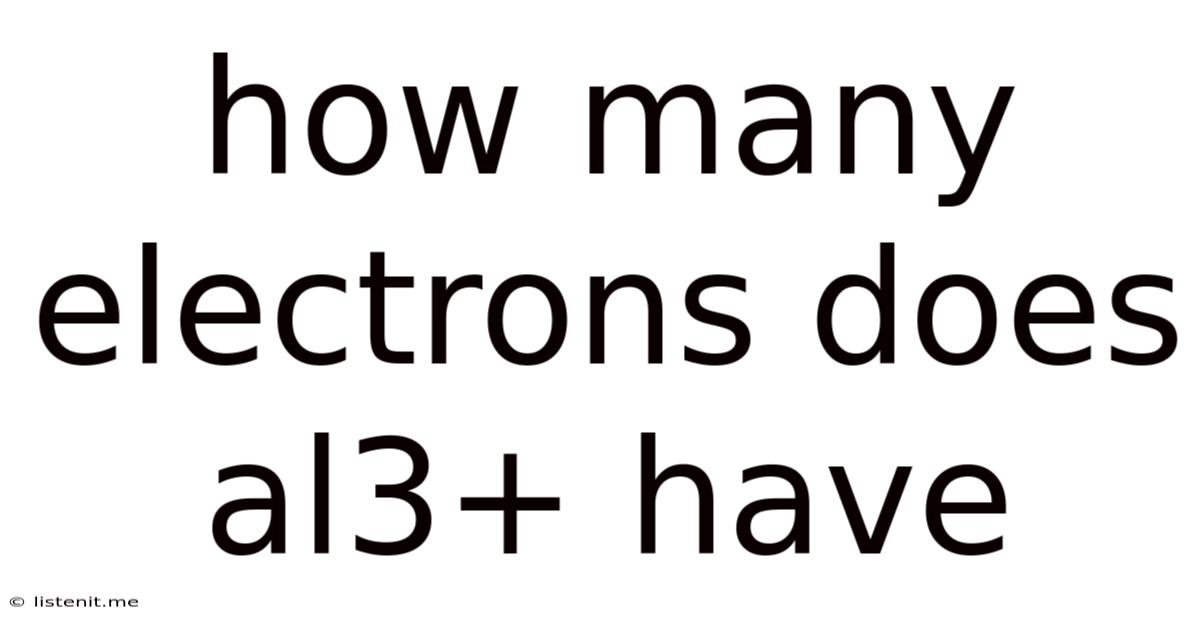How Many Electrons Does Al3+ Have
listenit
May 09, 2025 · 4 min read

Table of Contents
How Many Electrons Does Al³⁺ Have? Understanding Aluminum Ions
Aluminum, a ubiquitous element found in everything from soda cans to antacids, plays a vital role in various aspects of our lives. Its chemical behavior, however, is significantly influenced by its ability to lose electrons, forming ions. A common question that arises, particularly in chemistry studies, is: how many electrons does Al³⁺ have? This article delves deep into the electron configuration of aluminum, explains the formation of the Al³⁺ ion, and clarifies the number of electrons it possesses.
Understanding Aluminum's Electron Configuration
Before we explore the Al³⁺ ion, let's establish a solid foundation by understanding the electron configuration of neutral aluminum (Al). Aluminum, with an atomic number of 13, possesses 13 protons in its nucleus. To maintain electrical neutrality, a neutral aluminum atom also contains 13 electrons. These electrons are arranged in specific energy levels or shells around the nucleus according to the Aufbau principle and Hund's rule.
Electron Shell Arrangement in Aluminum
The electron configuration of aluminum is typically written as: 1s²2s²2p⁶3s²3p¹. This signifies:
- 1s²: Two electrons in the first energy level (n=1) in the s orbital.
- 2s²: Two electrons in the second energy level (n=2) in the s orbital.
- 2p⁶: Six electrons in the second energy level (n=2) in the p orbital.
- 3s²: Two electrons in the third energy level (n=3) in the s orbital.
- 3p¹: One electron in the third energy level (n=3) in the p orbital.
This arrangement reflects the lowest energy state for the aluminum atom. The outermost shell (valence shell), which is the third energy level (n=3), contains three electrons (3s²3p¹). These valence electrons are crucial in determining the chemical reactivity of aluminum.
The Formation of the Al³⁺ Ion: Losing Electrons
Aluminum is a highly reactive metal, readily losing its valence electrons to achieve a more stable electron configuration. This process is known as ionization. Aluminum achieves this stable configuration by losing its three valence electrons, transforming into a positively charged ion, denoted as Al³⁺.
Ionization Energy and Stability
The energy required to remove an electron from an atom is called ionization energy. Aluminum's relatively low ionization energies for its three valence electrons make it relatively easy for it to lose these electrons. This loss leads to a stable electron configuration that is isoelectronic with neon (Ne), a noble gas. Noble gases have completely filled valence shells, making them exceptionally stable and unreactive. This is the driving force behind aluminum's tendency to form a +3 ion.
Determining the Number of Electrons in Al³⁺
Now, let's address the central question: how many electrons does Al³⁺ have? Since aluminum loses three electrons to become Al³⁺, the number of electrons is simply the original number of electrons (13) minus the three electrons lost:
13 (electrons in neutral Al) - 3 (electrons lost) = 10 electrons in Al³⁺
Therefore, the Al³⁺ ion possesses 10 electrons. Its electron configuration mirrors that of neon (Ne), written as 1s²2s²2p⁶. This stable, octet configuration explains the Al³⁺ ion's relatively high stability.
Applications of Aluminum and its Ions
Understanding the properties of aluminum ions, particularly Al³⁺, is crucial in various scientific and technological fields. Here are some notable applications:
1. Metallurgy and Alloys
Aluminum's lightweight nature and corrosion resistance, primarily due to the formation of a protective oxide layer (Al₂O₃), make it invaluable in numerous alloys. The Al³⁺ ion plays a role in the formation of these protective layers, enhancing durability.
2. Catalysis
Aluminum compounds and its ions are utilized as catalysts in various chemical reactions, influencing reaction rates and selectivities.
3. Pharmaceuticals
Aluminum compounds are incorporated into some pharmaceuticals as antacids (to neutralize stomach acid) and as adjuvants in vaccines (to enhance the immune response). The Al³⁺ ion plays a significant role in the chemical interactions within these pharmaceutical applications.
4. Water Treatment
Aluminum salts are employed in water treatment processes as flocculants. The Al³⁺ ions help to coagulate suspended particles, leading to clearer water.
5. Ceramics and Glass
Aluminum compounds contribute to the properties of ceramics and glass, affecting their strength, durability, and thermal properties.
Conclusion: The Significance of Ionization
The formation of the Al³⁺ ion, and the understanding of its electron configuration, is fundamentally important in comprehending the chemical behavior and diverse applications of aluminum. The loss of three electrons to achieve a stable, noble gas-like configuration is a key characteristic that drives aluminum's reactivity and its role in various materials and processes. The simple answer to the question, "How many electrons does Al³⁺ have?" is ten. However, the deeper understanding of this answer reveals the intricacies of atomic structure, ionization, and the chemical properties that underpin aluminum's vast applications in modern technology and everyday life.
This detailed explanation should provide a comprehensive understanding of the electron configuration of aluminum, the formation of the Al³⁺ ion, and the significance of its ten electrons. Remember to always consult reliable chemistry resources for further in-depth learning.
Latest Posts
Latest Posts
-
Least Common Multiple Of 3 9 15
May 09, 2025
-
The Length Of A Rectangle Is Four Times Its Width
May 09, 2025
-
What Is 0 82 As A Fraction
May 09, 2025
-
As The Wavelength Increases The Frequency
May 09, 2025
-
State Of Matter At Room Temperature For Titanium
May 09, 2025
Related Post
Thank you for visiting our website which covers about How Many Electrons Does Al3+ Have . We hope the information provided has been useful to you. Feel free to contact us if you have any questions or need further assistance. See you next time and don't miss to bookmark.